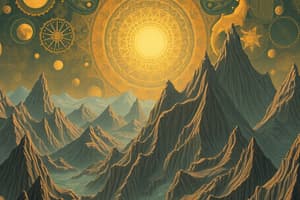Podcast
Questions and Answers
What is the primary cause of normal faults?
What is the primary cause of normal faults?
Which type of seismic wave is known to cause the most destruction during an earthquake?
Which type of seismic wave is known to cause the most destruction during an earthquake?
In which type of plate boundary would you expect to find the Himalayas?
In which type of plate boundary would you expect to find the Himalayas?
What process is primarily associated with volcanic activity at convergent plate boundaries?
What process is primarily associated with volcanic activity at convergent plate boundaries?
Signup and view all the answers
What characterizes composite volcanoes?
What characterizes composite volcanoes?
Signup and view all the answers
What term is used for the point located on the Earth's surface directly above the focus of an earthquake?
What term is used for the point located on the Earth's surface directly above the focus of an earthquake?
Signup and view all the answers
Which of the following is NOT considered a type of volcano?
Which of the following is NOT considered a type of volcano?
Signup and view all the answers
What is the purpose of a seismograph?
What is the purpose of a seismograph?
Signup and view all the answers
Study Notes
Plate Boundaries
- Divergent Boundaries: Where tectonic plates move apart, allowing magma to rise from the mantle and form new crust. Example: Mid-Atlantic Ridge.
- Convergent Boundaries: Where tectonic plates collide, resulting in one plate subducting (sinking) beneath the other or a collision zone, leading to mountain building. Example: Himalayas.
- Transform Boundaries: Where tectonic plates slide past each other horizontally, creating friction and generating earthquakes. Example: San Andreas Fault.
### Earthquakes
- Focus: The point inside the Earth where an earthquake originates.
- Epicenter: The point on the Earth's surface directly above the focus.
- Magnitude: A measure of the energy released during an earthquake, often measured using the Richter scale.
- Seismograph: An instrument used to record seismic waves.
Seismic Waves
- Primary Waves (P-Waves): The fastest type of seismic wave, travelling through solid, liquid, and gaseous mediums.
- Secondary Waves (S-Waves): Slower than P-waves, capable of travelling only through solid mediums
- Surface Waves: The slowest type of seismic wave, but also the most destructive, travelling along the Earth's surface.
Volcanoes
- Shield Volcanoes: Broad and gently sloping volcanoes formed by low-viscosity lava eruptions.
- Composite Volcanoes (Stratovolcanoes): Steep, cone-shaped volcanoes known for their explosive eruptions alternating layers of lava and ash.
- Cinder Cone Volcanoes: Small, steep-sided volcanoes composed of pyroclastic fragments.
Volcanic Hazards
- Lava Flows: Streams of molten rock erupting from a volcano.
- Ash Falls: Volcanic ash falling from the sky, posing a hazard to air travel and infrastructure.
- Pyroclastic Flows: Fast-moving currents of hot gas and volcanic material, capable of causing immense destruction.
Volcanic Structures
- Magma Chamber: A large pool of molten rock beneath the Earth's crust.
- Main Vent: The primary opening through which magma rises to the surface.
- Throat: The uppermost section of the main vent, where magma accumulates before eruption.
- Crater: A bowl-shaped depression at the summit of a volcano created by explosive activity.
- Conduit: A passage that allows magma to travel from the magma chamber to the surface.
- Lava Flow: Molten rock flowing out of a volcano during an eruption.
- Ash Cloud: A cloud of ash formed during explosive volcanic eruptions.
- Secondary Vent: Smaller openings on the sides of a volcano through which magma can also escape.
- Secondary Cone: Smaller cones formed by eruptions from secondary vents.
- Eruption Column: A towering plume of ash, gas, and volcanic material ejected into the atmosphere during an eruption.
- Lava Dome: A mound formed when viscous lava accumulates near the vent, unable to flow freely.
- Fumaroles: Openings in the Earth's crust that emit steam and gases.
- Sills: Horizontal intrusions of solidified magma between existing rock layers.
- Dikes: Vertical or steeply inclined intrusions of solidified magma that cut through existing rock layers.
- Caldera: A large, basin-like depression formed when a volcano collapses into itself, often after a major eruption.
- Lahar: A destructive mudflow on the slopes of a volcano, typically composed of volcanic ash mixed with water.
Studying That Suits You
Use AI to generate personalized quizzes and flashcards to suit your learning preferences.
Description
Explore the fundamentals of plate boundaries and seismic activity in this engaging quiz. Learn about divergent, convergent, and transform boundaries, as well as key concepts like focus, epicenter, and seismic waves. Test your knowledge on how these geological processes shape our planet.




